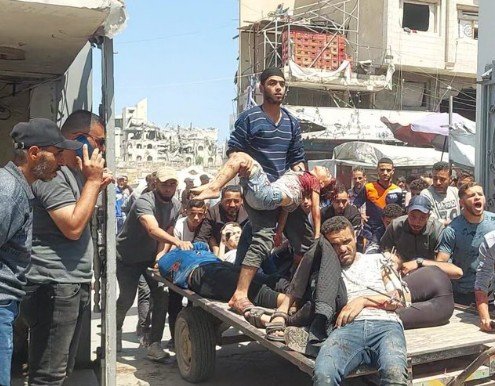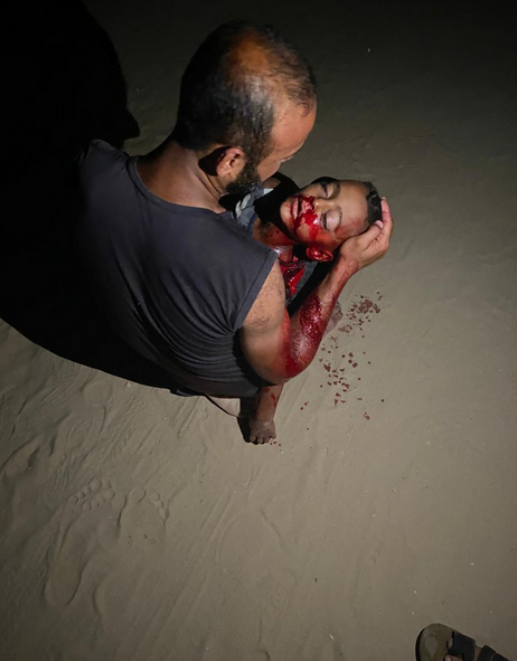A War Beyond Borders: The Human Toll of the Gaza Crisis
The latest escalation in Gaza has once again laid bare the staggering human cost of a conflict that has long outgrown its political justifications. With over 58,000 Palestinians dead since October 2023—more than half of them women and children—what unfolds in Gaza is no longer just a war. It is a humanitarian catastrophe, a failure of global morality, and a modern massacre unfolding in full view of a watching yet unmoved world.
From the deliberate bombing of densely populated neighborhoods to the indiscriminate strikes on schools, hospitals, and even water collection points, Gaza has become a graveyard for international law. The war, supposedly fought under the guise of self-defense or counter-terrorism, is now more accurately defined by its mass civilian bloodshed and moral collapse.

Targeting Life Itself: Strikes on the Vulnerable
One of the most harrowing recent incidents occurred on July 13, 2025, in Nuseirat, central Gaza. As children gathered to collect water—a basic need made rare by the destruction of Gaza’s infrastructure—an Israeli missile, reportedly malfunctioning while targeting a militant, exploded at the water distribution point. At least 8–10 people, mostly children, were instantly killed. These children were not fighters. They were simply trying to survive amid dehydration, displacement, and starvation.
The Israeli Defense Forces admitted it was a “technical error,” but what does such an admission offer to the families left with charred bodies and shattered futures? It only underscores the bitter truth: even “mistakes” in this war disproportionately slaughter civilians, revealing a complete disregard for human life when the targets are Palestinian.
Massacres Disguised as Strategy
Beyond isolated “errors,” there have been consistent, intentional attacks on spaces meant to be safe havens. The Al-Ahli Arab Hospital blast on October 17, 2023, killed between 471–500 people, including children and women seeking refuge. Eyewitnesses described body parts scattered across the courtyard—babies, mothers, and elderly whose features were rendered unrecognizable. Hospitals, protected under international law, have now become prime targets in a war that defies every ethical standard.
On November 9, 2023, Israeli forces bombed Al-Buraq School, a United Nations-run shelter. 50 civilians were killed. Another school in Hamama was attacked in August 2024, claiming 17 lives, many of them children.
Perhaps the most tragic was the Al-Najjar family massacre on May 23, 2025, where nine out of ten siblings—ranging from 7 months to 12 years—were killed in a single airstrike. These are not just numbers; they are stolen futures, mutilated innocence, and stories buried beneath rubble.
Global Hypocrisy and Media Silence
The international community’s reaction remains disturbingly muted. While global powers quickly condemn violence elsewhere, the response to Gaza has been lukewarm, selective, and politically cautious. Geopolitical alliances and double standards paralyze international action, reducing institutions like the United Nations to toothless observers.
Mainstream media, particularly in the West, often sanitizes the war narrative, centering the right of Israel to self-defense while marginalizing or minimizing Palestinian suffering. This imbalance skews public perception and obstructs meaningful discourse. In doing so, it dehumanizes the victims and normalizes their deaths as unfortunate but inevitable.
War Crimes Behind the Veil of Legitimacy
International law, including the Geneva Conventions, clearly prohibits attacks on civilians and non-military infrastructure. It demands proportionality and the protection of non-combatants. The repeated assaults on hospitals, schools, and homes in Gaza are not just tragic—they constitute war crimes.
The oft-repeated justification of “human shields” is insufficient. Even if militants operate in civilian areas, the legal and moral responsibility remains with the attacking party to avoid civilian harm. Waging war in such a densely populated strip inherently leads to massive loss of life. If the strategy itself is built on the back of human death, the strategy is broken—and so is the conscience of its architects.
The Psychological and Generational Ruin
Beyond the physical destruction, the long-term psychological impact is immeasurable. Children in Gaza are growing up amid trauma, loss, and fear. Entire generations are being scarred by a reality of constant bombardment, dead relatives, and destroyed futures. The normalization of violence breeds cycles of hatred and despair that no peace process can easily erase.
These are not “collateral damages.” These are deliberate, systemic failings of the international order to protect the most basic right—the right to live.
Time to Choose: Humanity or Hypocrisy
The Gaza conflict is no longer just a political dispute. It is a test of global humanity. The world must decide whether it will continue to turn a blind eye while civilians bleed in the name of politics—or whether it will demand accountability, justice, and peace.
If we fail to act now—if we allow children to be killed while collecting water, or families to be bombed in their sleep—then the next massacre is not just inevitable; it is permitted.
History will judge us, not by our speeches, but by our silence. And Gaza’s blood will be the ink.








